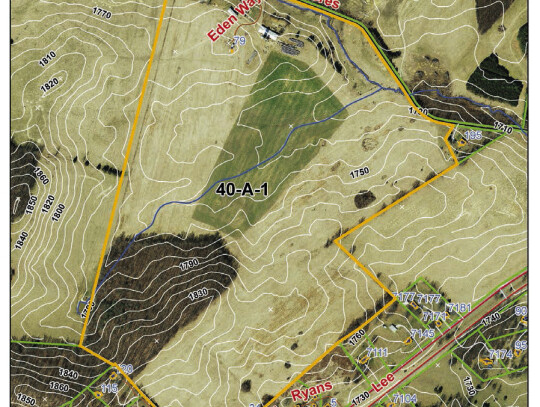Two commercial-scale solar arrays proposed for opposite ends of Rockbridge County have drawn opposition from neighbors and the Planning Commission.
The Commission last Wednesday voted 3-1 to recommend denial of special exception permits for the solar arrays proposed for farms near Raphine and Natural Bridge Station. Both votes followed public hearings in which neighbors raised objections to the solar projects.
Volcano Energy LLC is proposing a 5.0 megawatts solar array that would go on 65 acres of Sylvia G. Moore’s 150-acre farm south of Moores Trail near Raphine, between U.S. 11 and Interstate 81. USS Hilltop Solar LLC is seeking to put a 3.0 megawatts solar array on 21 acres of a 141-acre farm owned by Douglas E. and Joan E. Braford trustees near Natural Bridge Station, on the west side of the intersection of Lloyd Tolley (Va. 773) and Gilmores Mill (Va. 708) roads.
About 20 speakers who addressed the Commission during the public hearing on the Volcano project expressed opposition.
Turning good farmland with high quality soils into a solar field, said adjacent landowner Tim Clark, “should not even be up for consideration by the Planning Commission, as it flies directly in the face of a comprehensive strategy of maintaining and preserving agriculture soils of the highest quality as an important natural resource.” Removing farmland from agricultural production, said Luke Grant, takes opportunities away from the next generation of farmers. “If we keep taking away our precious farmland,” he asked, “[what are we going to have left?] We need to preserve it; we don’t have much more to sacrifice …” Cynthia Kator said that only 18 percent of land in the U.S. is sufficiently arable to grow crops. A solar project won’t be “helpful for our tax base,” she noted. Reclamation costs estimated at $218,000 by the applicant won’t be nearly enough money to return the land to agricultural production, she asserted, when the project goes off-line in 25-40 years.
“What would you rather see – cornstalks or solar panels?” asked Richard Grant. “Cornstalks are harvestable. You can redo the ground, you can put the grass back in. These solar panels – what are you going to do at the end of 25 years? … We’ve got to preserve the land.”
Allen Stout, a neighboring landowner, said the solar panels would destroy a “panoramic view” he now enjoys of farmland and mountains. He said it “breaks my heart” to “look at poles sticking out and land stripped” on a Fairfield farm that has a solar array under construction. He alleged that the “electromagnetic waves” emanating from solar panels would “shorten lives.”
When discussion returned to the Commission, Robert Lucas observed that the citizens’ comments were similar to views expressed during a work session that preceded the regular meeting. The proposed solar array, he said, “is going to affect qualify of life and land values – two of the things we have to look at as planning members. Our job is to protect them – their investment and qualify of life.”
David Whitmore said he was “not ready for a motion to approve or deny” a special exception permit for the project. He compared the situation to a “popularity contest” in which “obviously, we know who would lose this one, with the turnout today.”
The Commission’s job, as he sees it, is to determine whether the proposal complies with the criteria of the county’s comprehensive plan.
“There is something to balancing the property rights as well,” he added. The proposal “merits a little more consideration, maybe some additional conditions.” The applicant, he said, “offered to meet with everyone after this meeting” to address the concerns raised.
Melissa Hennis pointed out that she was the only member of the Commission to vote against the solar field now under construction on the Alexander farm near Fairfield. “I have grave concerns about what we’re doing to our community – the fact that we have very little farmland left.”
As for the proposal under consideration, she said, “I don’t think this is the place for it. I do think there are some places for it.”
She reminded everyone that she had voted in favor of solar projects in Rockbridge Baths (on the Mohler farm) and near Kerrs Creek (BARC Electric’s array at the former Highland Belle school).
She continued: “When I hear that [the proposed Volcano solar array] is in compliance with our comprehensive plan, I don’t see how this is creating any jobs for us. I don’t see where it’s creating a tax benefit for us. I don’t see it as increasing anyone’s personal income in Rockbridge County. These are out-of-town people who we don’t know who they are. In 30 years, when we go to decommission, are we going to be filling up our landfill. … What are we going to eat when there’s no farmland left? … We need to have an ordinance that says what we’re looking for.”
At the conclusion of the discussion, Lucas made a motion to recommend denial of a special exception permit for the Volcano solar array. The motion, seconded by Robert Kramer, passed 3-1, with Hennis, Kramer and Lucas voting in favor and Whitmore dissenting. Shan Watkins was absent.
A similar discussion ensued with the next agenda item – the proposed USS Hilltop solar array for the Braford property near Natural Bridge Station. Eight citizens spoke in opposition to the project during the public hearing. Just before the Commission took a vote on the project, county attorney Vickie Huffman reminded members that they could only take into consideration the county’s current regulations, not a possible new ordinance that may go on the books in the future.
A motion by Lucas, seconded by Kramer, to recommend denial of a special exception permit for the USS Hilltop solar array also passed 3-1, with each member voting the same way as before.
Both solar array proposals, with the negative recommendations from the Planning Commission, are slated to go before the Board of Supervisors on Nov. 6.
.jpg)




